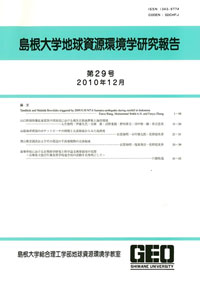島根大学総合理工学部地球資源環境学教室
ISSN:1343-9774

number of downloads : ?
Use this link to cite this item : https://ir.lib.shimane-u.ac.jp/6395
Geoscience reports of Shimane University 17
1998-12-25 発行
Geochemical implication for the maximum flooding of the Jomon transgression in the coastal lagoon sediments, San'in district, SW Japan
Geochemical implication for the maximum flooding of the Jomon transgression in the coastal lagoon sediments, San'in distdct, SW Japan
Ishiga, Hiroaki
Interdisciplinary Faculty of Science and Engineering, Department of Geoscience, Shimane University
Sampei, Yoshikazu
Interdisciplinary Faculty of Science and Engineering, Department of Geoscience, Shimane University
Tokuoka, Takao
Interdisciplinary Faculty of Science and Engineering, Department of Geoscience, Shimane University
Takayasu, Katsumi
Research Center for Coastal Lagoon Environments, Shimane University
File
Description
The Holocene Jomon transgression was recorded in sediments at the archeological site in the Shimane University,which were deposited in the most inner part of the lagoon.Marine mud deposition in back marsh condition indicates start of the transgression,which is marked by the Kikai-Akahoya tephra of 6300 yrs BP.
Marine muds are characterized by fluctuating values of LOI(loss on ignition),total sulfur contents(TS),and Fe_2O_3 / Al_2O_3 ratios and these values are relatively higher than those of the non-marine ones in this section.Rb/K also shows fluctuation indicating Rb enrichment in under marine condition,probably related to Rb adsorption on clays.These sediments of this section show higher CIA(80~85)suggesting derivation of highly weathered material from the source or sorting of the clays.Ti/Zr shows gradual increase in the Jomon age,suggesting
heavy mineral fractionation related to the transgression.
High stand in sea-level probably lasted until middle Jomon age(4500 yrs BP),and consequently effects of fluvial inputs were dominated due to lowered sea-level.Gradual decrease in Al_2O_3 / TiO_2,SiO_2 / Al_2O_3 and Ti/Zr,and increase in Nb/Y and Zr/Y may be related to the source compositional changes due to the widening of the paddy field in the Yayoi age from 2400 yrs BP.
Marine muds are characterized by fluctuating values of LOI(loss on ignition),total sulfur contents(TS),and Fe_2O_3 / Al_2O_3 ratios and these values are relatively higher than those of the non-marine ones in this section.Rb/K also shows fluctuation indicating Rb enrichment in under marine condition,probably related to Rb adsorption on clays.These sediments of this section show higher CIA(80~85)suggesting derivation of highly weathered material from the source or sorting of the clays.Ti/Zr shows gradual increase in the Jomon age,suggesting
heavy mineral fractionation related to the transgression.
High stand in sea-level probably lasted until middle Jomon age(4500 yrs BP),and consequently effects of fluvial inputs were dominated due to lowered sea-level.Gradual decrease in Al_2O_3 / TiO_2,SiO_2 / Al_2O_3 and Ti/Zr,and increase in Nb/Y and Zr/Y may be related to the source compositional changes due to the widening of the paddy field in the Yayoi age from 2400 yrs BP.
Other Article
